DANGERS FACED BY JAPANESE FISHERMEN
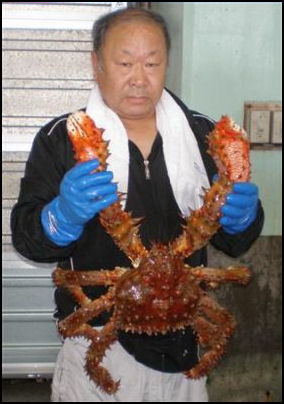
Every few months or so some fishermen go missing after their boat capsizes in rough seas or die when their boat collides with another vessel in Japan’s busy coastal waters. In September 2007, four fisherman went missing after their boats capsized off Kinkazan island in Miyagi Prefecture in southern Kyushu when winds picked up to 36 kph and waves were four meters in height. In April 2008, eight people died when their scallop-fishing boat sunk in rough seas off Aomori in northern Honshu.
In April 2004, three of four crew members aboard of South Korean fishing docked in the port of Oda were found dead, asphyxiated by a gas created by rotting squid guts slated to be used in a salted snack. The three men were found in sections of the ship where the guts were kept.
In September 2005, seven of eight fishermen were killed on 19-ton saury fishing vessel that capsized off of Nemuro, Hokkaido after it was struck by a 41,507-ton large Israeli-flagged container ship.
In December 2003, four died when a fishing boat sank off Shimane Prefecture. The 80-ton ship with a 10-man crew ran aground on a shoal and was overturned and sunk because of large waves and strong winds The surviving crew members were rescued clinging to rocks.
In October 2008, three fishermen were killed when a 14.75-ton fishing boat with six fishermen on board and a 9,813-ton cargo ship collided about 1.8 kilometers south of Minna Island in Okinawa Prefecture. All six of the fishermen were thrown into the water.
On April 2008, twelve of the 22 crew member aboard a Japanese fishing boat went missing after their 135-tom vessel capsized and sank off Hiradojima Island, Nagasaki.
In May 2009, a tuna boat caught fire and the crew had o abandon ship. Four people were initially reported missing. One was found dead, Another was found alive in a life raft. Two others were never found.
In October 2009, three men were rescued at sea after spending three days in an upside down capsized boat in seas off Hachijojima island. The men huddled in a small air pocket in a compartment of the 19-ton boat after it was capsized by waves from a typhoon. One survivor told Kyodo, “I was wondering inside the boat how I’d die. And it felt horrible to think about when I might stop breathing.” The three men had little to eat and shared a small amount of water. They were very hungry and slightly dehydrated when they were rescued by the Japanese coast guard. Five other crew men on the boat died.
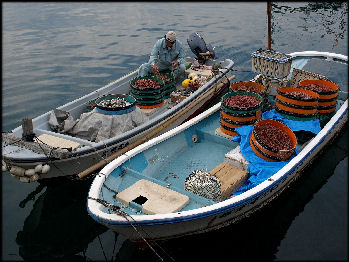
In 2008, fisherman in Surga Bay began wearing life jackets after a series of fatal boat accidents left five people dead.
In January 2008, a 55-year-old fisherman was rescued after treading water for 15 hours after his boat capsized off Miyakojima Island in Okinawa Prefecture
In July 2011, Kyodo reported that a 70-year-old fisherman adrift for 20 days was found safe by the Japan Coast Guard. Ryoko Shimabukuro, of Ie, Okinawa Prefecture, was found aboard the boat drifting off Cape Muroto, Kochi Prefecture, following a report sent by a foreign vessel to the 5th Regional Coast Guard Headquarters in Kobe. Shimabukuro appeared to be in good health and said his boat had encountered engine trouble, officials said. According to the fishing cooperative in his village, Shimabukuro left port June 8 and planned to return after around 10 days. He was last seen off Cape Hedo, Okinawa, on the evening of June 10. [Source: Kyodo, July 1 2011]
Japanese Fishing Boats in Russian Waters
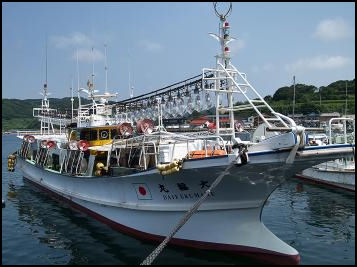
The Kuril Islands boast rich fisheries, with salmon, flounder, tuna, shrimp, clams, crab, kelp and sea urchins. A third of Russia's fish catch comes from the greater island region. The catch from the Kurils is worth over $1 billion a year.
Japanese fishermen who fish in waters off the islands do so at a high risk. Dozens of Japanese fisherman have been jailed for poaching and broaching Russian territorial waters. Russian border-patrol ships have injured fishermen and shot at and damaged Japanese vessels accused of fishing in Russia-claimed waters off the Kuril Islands.
Russian border-patrol ships have injured fishermen and shot at and damaged Japanese vessels accused of fishing in Russia-claimed waters off the Kuril Islands. Between the end of World War II and 2004, 1,330 Japanese fishing boats were captured by Russian patrol boars. In these incidents there has been only one fatality, in 1956.
In August 2006, a Russian Border Coast Guard patrol ship opened fire on a Japanese crabbing vessel, killing a fishermen, near Kalgarajima island,”part of the disputed Russian-controlled Kuril Islands territory. The captain and two crew members on the Japanese boat were taken into custody by the Russians. According to the Russians the Japanese were warned with flares and told to stop. The Russians said they only deciding to open fire — with machine guns from an inflatable boat — because the vessel tried to escape. Crew members taken into custody were freed a after a couple weeks. The captain was detained for seven weeks and released.
In June 2007, Russia seized a Japanese fishing boat that had permission to fish in Russian waters because it was carrying more fish than it was allowed and an expensive kind of salmon was falsely listed as a cheaper kind.
In December 2007, four Japanese fishing boats were seized off Kunashira Island in the Kurile Islands. The crew members were released a couple of months later
In January 2009, 10 fishermen in crab-fishing boat were arrested by Russian authorities waters on charges of poaching in Russia’s exclusive economic zone. The boat apparently drifted into the Russian zone while the fishermen were sleeping. The fishermen were released about week later after the payment of $140,000 by the firm that employed the fishermen. See Government, International, Russia, Kurile Islands
Fishing and Fuel Costs in Japan
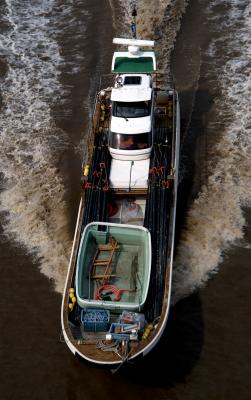
Soaring fuel costs have severely hurt the fishing industry. The further the vessels go out to sea, the more fuel they use, and the higher their cost are. Particularly hard hit are tuna boats which travel to distant areas and spend months at sea.
The cost of heavy fuel oil, the main fuel for fishing vessel, rose from about ¥39,000 per kiloliter n 2003 to ¥69,000 in 2007 to ¥105,000 in June 2008. Trawlers that operated in seas off Japan did everything they could to cut costs: operating their boats at lower speeds and using fewer fish luring lights, but still found their annual cost were about $50,000 higher than previous years.
Many fishermen were forced to stop working or scale back their operations. An estimated 40 percent of fishing operations faced bankruptcy. In June 2008, tuna fish boat operators in Japan, China, South Korea announced the were going to suspend operations for several months because of rising fuel costs. Because quotas for bluefin had already been met the ruling was expected to mostly effect fishing for bigeye and yellowfin tuna. Earlier in the month squid fisherman suspended work to draw attention to high fuel prices.
On one day in July 2008, 200,000 fishing boats — nearly all those operating in Japan’suspended operations to bring attention to their plight and seek government help.
Huge Jellyfish Off Japan
Echizen jellyfish — nasty creatures that can weigh up to 200 kilograms and reach a size of two meters in diameter — have caused havok in the Japanese fishing industry, particularly in the Sea of Japan off of Fukui, Shimane and Ishikawa Prefecture in western Honshu. The jellyfish have brown poisonous tentacles that kill fish and cause them to lose their color. Their huge numbers spoils fish catch and fouls fishing nets with a nasty smell. Their massive weight tears the nets when they are pulled out of the water.
The damage to the fishing industry has been in the tens of billions of yen. On fisherman told the Yomiuri Shimbun, “The nets were fouled by hundreds of jellyfish as soon as they were put out. There was little room for other fish, The fish that touched the tentacles of the jellyfish turned white, and the retail value of the fish is reduced to zero.” The presence of the poisonous jellyfish has been particularly devastating to the fishing for cavalla and yellowtail because these fish stay well clear of the jellyfish.
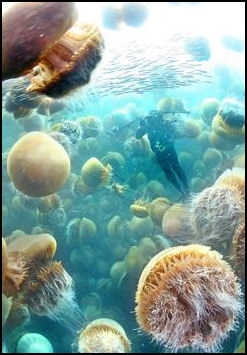
The jellyfish population explosions have been blamed on global warming, increased nutrients in the water, and overfishing of jellyfish competitors. In the old days Echizen jellyfish disappeared by the time the autumn fishing season peaked. But warmer waters, perhaps caused by global warming, have caused the jellyfish to stick around longer than in the past. Some blame China for the problem, saying the jellyfish originate in waters off the coast China and their growth has been triggered by pollutants dumped in the sea.
To combat the jellyfish problem the Japanese government has set up observation stations and provided forecasts for jellyfish invasions. Boats carry nets outfit with special blades that cut the jellyfish into little
People are also trying to come up with uses for Echizen jellyfish. An aquarium in Yamagata Prefecture sells a variety of Echizen jellyfish, including an ice cream containing diced jellyfish. Researchers have found that protein extracted from the jellyfish helps joint cartilage grow,.
Giant Jellyfish Migrations
The large jellyfish have appeared every year since 2002. Before that they showed up once every few decades. They originate in waters off the coast of China in the Yellow and Bohai Seas and migrate past South Korea to southern Japan. They get their Japanese name Echizen kurage after Echizen, the old name for a port in Fukui Prefecture, where the jellyfish were spotted.
In 2005 — a particularly bad year — an estimated 300 million to 500 million Echizen jellyfish passed into the Sea of Japan through Tsushima Strait and spread to the Pacific and were found in most coastal areas of Japan.. In some place the sea was literally engulfed in them. More than 100,000 complaints about giant jellyfish were lodged, mostly damaged nets and lost fishing time. In 2006 huge masses of Echizen jellyfish appeared in the Sea of Japan after a typhoon passed through the region in mid September,
The worst infestation of Nomura’s jellyfish in four years was witnessed in 2009. What was usual about that year was that for the first time the jellyfish made it to the Pacific from the Sea of Japan through the Tsugaru Strait between Hokkaido and Honshu and from there migrated south, making it Tokyo four months after first appearing off the west coat of Kyushu. In Chiba a fishing boat overturned from he weight of trying to lift a net full of jellyfish out of the water.
Some scientists blame overfishing and global warming for the jellyfish swarms. Prof. Shinichi Ue, an expert on the jellyfish at Hiroshima University, told the Yomiuri Shimbun, “Humans have brought about abnormalities in the marine eco-systems that can no longer be corrected...As mall fish and fry of large fish have fallen in number, creatures that prey on Echizen jellyfish, which eat zooplankton, also have decreased.
When the jellyfish polyps are developing they sometimes leave “legs” — podocysts which can develop into jellyfish — on rocks that lie dormant when the water is relatively cool. When the water temperature rises above a certain level the “legs” can develop into polyps and then become jellyfish. Dr. Toru Yasuda, an expert on the jellyfish at Fukui University, told the Yomiuri Shimbun, “The rise in water temperature might have encouraged podocysts to sprout and polyps to grow.”
Japanese scientist have asked Chinese scientists to cooperate with them in a study of jellyfish, focusing on the mouth of the Yangtze River, measuring the water quality and temperatures amd other variables and see if these provide clues to how the jellyfish evolve.
Japan and International Fishing Laws
Japan has ignored international fish quotas on whales and blue fin tuna and refused to sign international fishing treaties.
Japan has traditionally been a major advocate of “fishing freedom.” Although it ratified the United Nations Convention on the Law of the Sea — which states that nation obliged to cooperate with control of “highly migratory” fish such as tuna Japan has not been very active in fish control. Until recently Japan had been unwilling to join the United Nations Fish Stocks Agreement, which sets rules on fishing of certain kinds of fish but finally ratified it in 2006. In some cases Japan had boycotted and disrupted meetings aimed at establish controls on fishing in certain areas of the Pacific.
In January 2007, Kobe hosted an international conference on overfishing. The fishing industries and governments of about 80 countries participated, . On the top of the agenda was the problem of the overfishing of tuna. A plan was adopted to slow the decline of global tuna stocks by aggressively combating illegal fishing, controlling the growth of fishing fleets and sharing data on stock sizes.
Whaling, See Nature and Science, Sea
Japan has wrangled with Australia and New Zealand over quotas on the catch of southern bluefin tuna in waters near Australia and New Zealand. Currently Japan is limited to an annual catch quota of 6,000 ton plus a research-fishing catch of 1,400 tons.
See Kurile Islands Above
See Korea
Japan and Drift Nets
Japan was once one of the leading users of drift nets but stopped in 1992 under U.N. pressure.
In the 1980s it was estimated that the number of birds, marine mammals and unwanted fish killed by drift nets from Japanese, Korean and Taiwanese fishing boats far outnumbered the fish sold in markets. Some drift nets were 30 miles long and were used primarily to catch squid and tuna. Most of the other fish caught are tossed overboard. The United Nations passed a resolution that has ended a practice sometimes called "strip mining of the sea" but enforcement in the vast ocean has been difficult.
Illegal Crab Fishing in Russia and Japan
Fishing for king crab off the Kamchatka peninsula is especially lucrative. After the crabs are caught the vessels travel a few hundred miles south and sell the crabs for a lot of money in Japan. Many the ships use forged documents to clear customs. In the Kamchatka peninsula in eastern Russia, fishing permits are technically free but people have been known to pay $2.5 million for a hundred-ton quota to fish crab.
Rusted boats haul in as much as 50 tons of king crab a day from the nutrient-rich Sea of Okhotsk. After the day's catch is hauled a work force of 427 men work through the night below the deck cooking and canning the crabs for market.∞
As of 2002, before a crackdown on illegal crab fishing, Russia accounted for half of Japan’s total crab supply of 160,000 tons a year. Buyers in Japan pay between $50 and $75 per kilogram.
Japan and Illegal Crab Fishing in Russia
The Russian crab fishermen traditionally pulled into Japanese ports like Nemuro and Kushiro with forged papers, sold their catch for a huge profit, partied and bought stereos, televisions and other electronics, or maybe even a car, and returned to Russia, hopefully avoiding Russia coast guards boats whose primary duty is catching poachers and who are ordered to shoot at boats the at don’t stop..
Many of the boats involved in the illegal fishing trade are rusting heaps that lack safety equipment and sometimes working emergency radio. The men that work the boats are rough and cruel. A few have tattoos on their eyelids.
In 1998, Japan imported 70,000 tons of crab from Russia. Only 5,000 tons of that was documented on the books in Russia. In 2000, 86 ,000 tons of crab came from Russia. Only 3,000 tons of that was documented on the books in Russia.
In 2002, the Japanese government began cracking down on crab smuggling. Russian ships fully loaded with crab that lacked proper documents were tuned away from Japanese ports. Afterwards the price of crab soared in Japan by more than 50 percent, which cerated more incentive for those involved in the illegal crab trade. The Japanese crackdowns came in after Japan and Russia set up a notification system in which Russia provided Japan with prior notification of ports of calls for a its fishing oats. The crackdown also hurt the economy in the ports of call. The Russian spent a lot of money in Japan on used cars, electronics and other stuff they took back with them to Russia.
Before the crackdown the fishing boats traveled on their own directly to Japan. Afterwards they tried to outsmart authorities by loading their catch onto cargo freighters at sea and those freighters, which had proper documentation, docked at the ports. In one case the captains of a freighter and trawler were arrested after they were transferring a load of crab with Japanese waters.
The Russian sea urchin and shrimp industry operates much like the crab industry.
Fishing Bribes, Japan and Russia
In 2010, it was revealed that four Japanese companies paid Russian border guards about $6 million for tacit permission to catch walley pollack in excess their quotas. The companies were ordered to suspend operations for 70 days during the heart of the fishing season from late January to March.
Fishery executives said that bribing the Russians was a common almost expected practice. The executives said they handed cash to Russian border guards or made money transfers through Cyprus accounts and said it was a necessary part of doing business. “We did it to catch more fish than is legally allowed,” one official said.
Image Sources: 1) JNTO, Ray Kinnane, Hector Garcia, xorsyst blog, Andrew Gray Photosensibility, Visualizing Culture, MIT Education
Text Sources: New York Times, Washington Post, Los Angeles Times, Daily Yomiuri, Times of London, Japan National Tourist Organization (JNTO), National Geographic, The New Yorker, Time, Newsweek, Reuters, AP, Lonely Planet Guides, Compton’s Encyclopedia and various books and other publications.
Last updated August 2012
